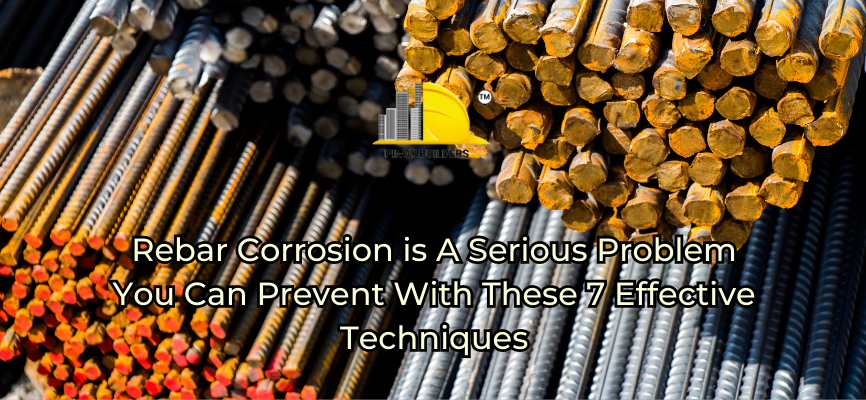Rust stains, cracks, spalling, delamination, and exposed rebars are signs of rebar corrosion. Rebar corrosion is a serious problem that the construction industry constantly faces. Once it happens, it can cause significant damage to structures or materials that are to be used in construction. In this article, we will discuss what rebar corrosion is, its causes, its impacts, and most importantly, how to prevent it.
What is Rebar Corrosion and What are its Causes?

Source: Galvanize It!
Most houses, bridges, buildings, skyscrapers, and other structures are built with concrete and embedded reinforcement steel called rebar. Rebars are strong in tension and compression, which provides additional strength to concrete which is weak in tension. Overall, this combination helps construction professionals build structures that last.
However, rebars can corrode because of chemical or electrochemical reactions inside the concrete. This type of corrosion is called rebar corrosion. During their lifetime, rebars get corroded because of exposure to moisture (which can be caused by moisture seepage, exposed rebar, leakage, carbonation, ingress of seawater, calcium chloride, etc.) and electrolysis caused by current passing through concrete and reinforcement steel.
What are the Impacts of Rebar Corrosion?
Rebar corrosion causes major problems in concrete structures which can have a significant impact on the structure’s durability, safety, and aesthetics. Here are the impacts of rebar corrosion on concrete structures:
1. Reduced structural integrity: Corrosion weakens the rebar and causes it to lose its strength and compromises structural integrity. With compromised structural integrity, a bulding can become at risk of collapsing, which can then result in serious injury or death.
2. Aesthetic damage: Rebar corrosion causes unsightly rust stains on surfaces. These stains are difficult and may cost a lot to remove.
3. Increased maintenance costs: Rebar corrosion is difficult and expensive to repair. This leads to increased maintenance over the lifespan of the structure.
4. Decreased lifetime of the structure: Corrosion significantly shortens a concrete structure’s lifespan, leading to premature deterioration, replacement, or major repairs.
Overall, rebar corrosion has significant impacts on the safety, aesthetics, durability, and lifespan of a concrete structure. Without preventive measures, property owners will find themselves occupying a structure with compromised safety and an increase in costs of maintenance.
How to Prevent Rebar Corrosion?
Fortunately, rebar corrosion is preventable. Here are 7 ways to prevent rebar corrosion and the problems that come along with it.
1. Properly cover the rebar.

Ensure that the rebar is properly covered with concrete to prevent moisture and air from coming into contact with the rebar. Thus, preventing corrosion.
2. Use corrosion-resistant materials.
Did you know that there are concrete reinforcement materials that are corrosion-resistant? Materials such as stainless steel, epoxy-coated rebar, and glass fiber-reinforced polymer rebars are corrosion-resistant rebar materials that are available in the Philippine Market.

Glass Fiber Reinforced Polymer Rebar. Source: MRG-Composites
3. Switch to a good-quality concrete mix.
A good quality concrete mix with low water–cement ratio minimizes the amount of water that can seep into the concrete and reach the rebar.
4. Adequate drainage.
Provide adequate drainage to prevent water from pooling around the rebar during construction. This will reduce the risk of the rebar developing rust and other damage.
5. Apply protective coatings.

Applying protective coatings such as metal and epoxy primers on rebar before adding the concrete mix helps prevent exposure to moisture and air.
6. Utilize a Cathodic protection.
Cathodic protection (CP) is a technique that helps control corrosion on metal surfaces. According to Abriox, the simplest method to apply CP is by connecting a metal such as steel rebars to a more easily corroded metal that will act as an anode of the electrochemical cell. This process helps counteract the corrosion process.
7. Regularly perform inspection and maintenance.
Regular inspection for signs of corrosion and taking necessary measures help in preventing corrosion from spreading.
Conclusion
Rebar corrosion is a serious problem that can cause problems that impact structure safety, durability, and aesthetics. By applying corrosion prevention methods, you can mitigate or prevent rebar corrosion from causing major damage, unsightly stains, and expensive maintenance costs on concrete structures.
References:
Corrosion of Steel Reinforcement in Concrete: Detecting, Mapping, and Monitoring. (n.d.). GlobalGilson.com. https://www.globalgilson.com/blog/corrosion-of-concrete#:~:text=Obvious%20signs%20include%20rust%20stains,to%20complete%20demolition%20and%20replacement.
Corrosionpedia, W. I. R. C.-. D. F. (2018, November 19). Rebar Corrosion. Corrosionpedia. https://www.corrosionpedia.com/definition/1380/rebar-corrosion#:~:text=Rebar%20corrosion%20occurs%20when%20chloride,steel%20throughout%20the%20support%20structures.
Bhuvaneshwari, B., Selvaraj, A., & Iyer, N. R. (2006). Corrosion inhibitors for increasing the service life of structures. Principles of Corrosion Engineering and Corrosion Control. https://doi.org/10.1016/b978-0-12-818961-0.00020-x
Trenchlesspedia, W. I. R. C.-. D. F. (2019b, November 7). Rebar Corrosion. Trenchlesspedia. https://www.trenchlesspedia.com/definition/4245/rebar-corrosion
Causes of Corrosion of Reinforcement Steel in Concrete. (n.d.). https://gharpedia.com/blog/causes-of-corrosion-of-reinforcement-steel/
Fernandez, I., Herrador, M. F., Marí, A., & García, J. M. B. (2016). Structural effects of steel reinforcement corrosion on statically indeterminate reinforced concrete members. Materials and Structures, 49(12), 4959–4973. https://doi.org/10.1617/s11527-016-0836-2








